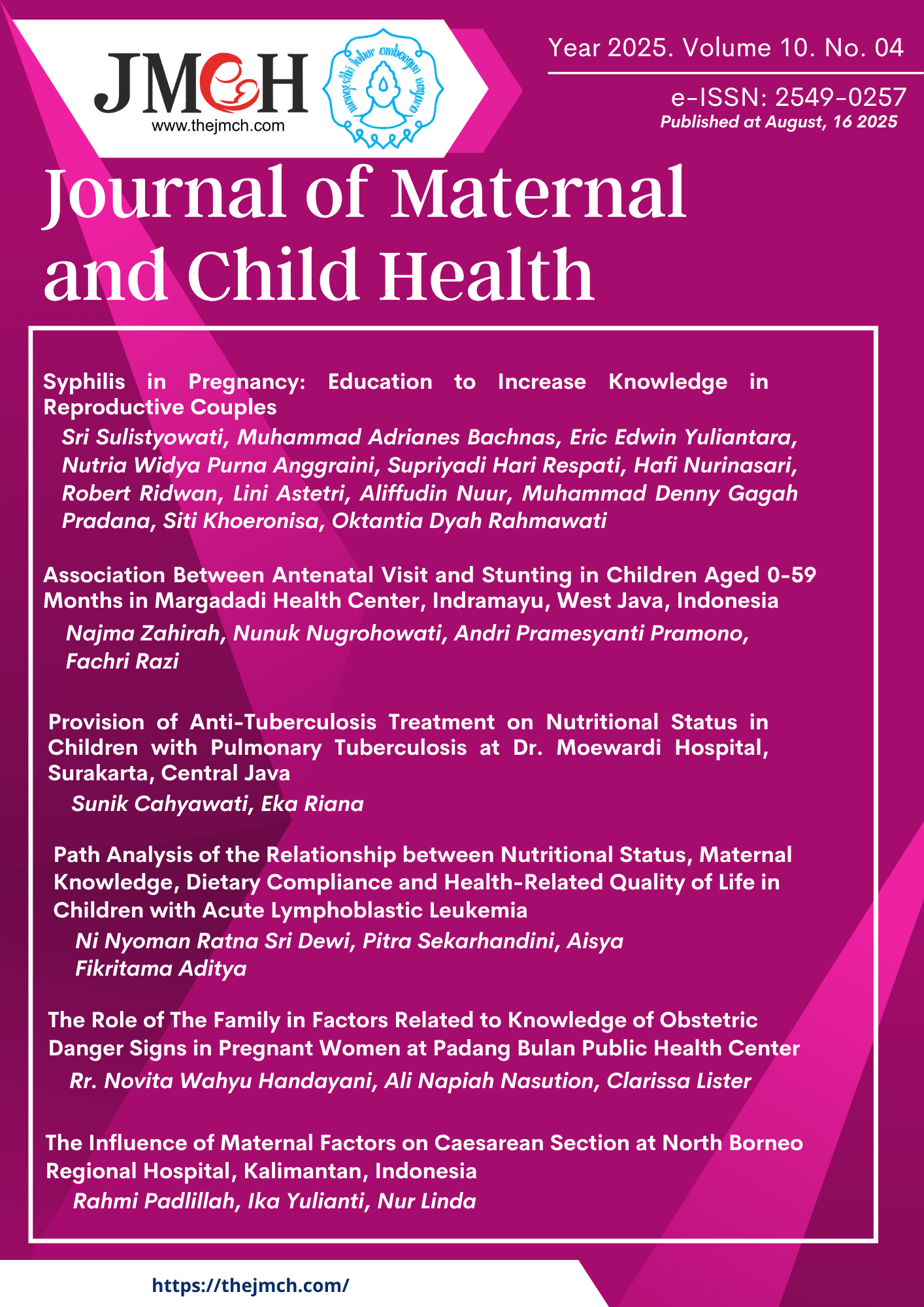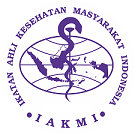Provision of Anti-Tuberculosis Treatment on Nutritional Status in Children with Pulmonary Tuberculosis at Dr. Moewardi Hospital, Surakarta, Central Java
DOI:
https://doi.org/10.26911/thejmch.2025.10.04.03Abstract
Background: Tuberculosis caused by Mycobacterium tuberculosis, remains a significant global health issue. In Indonesia, the number of childhood TB cases has risen substantially from 33,366 in 2020 to 56,622 in 2022. TB can contribute to nutritional disorders, while treatment with anti-tuberculosis drugs (OAT) may help improve nutritional status. This study aims to evaluate the differences in nutritional status among toddlers with pulmonary TB before and after receiving OAT treatment at Dr. Moewardi Regional General Hospital, Indonesia.
Subjects and Method: This study utilized a comparative analytical design with a cross-sectional approach and employed a retrospective purposive sampling technique. It was conducted at Dr. Moewardi Regional General Hospital from 2017 to 2024 using a total sampling method, identifying the nutritional status of toddlers before and after OAT administration. The dependent variable was anti-tuberculosis drugs (OAT) treatment The independent variables was nutritional status Resulting in 42 samples that met the inclusion and exclusion criteria for toddlers aged 1–5 years. Data were processed using SPSS and analyzed with the Wilcoxon signed-rank test.
Results: The male gender was higher by 25 people (59.52%) and female by 17 people (40.47%). The highest age sample of toddlers before treatment was 2 years (33.33%) and after treatment 3 years (33.33%). The highest nutritional status before OAT treatment was malnutrition (59.52%) while after treatment it was good nutrition (66.66%). The nutritional status of toddlers was higher (Mean = 2.90; SD = 0.57) than before (Mean = 2.12; SD = 0.63), and this result was statistically significant (p<0.001).
Conclusion: There is a significant differences between the nutritional status of toddlers suffering from pulmonary tuberculosis before and after OAT treatment at Dr. Moewardi Regional General Hospital.
Keywords:
pulmonary tuberculosis, nutritional status, anti-tuberculosis drugsReferences
Amala K (2016). Perbedaan status gizi pasien TB paru sebelum dan 6 bulan sesudah pengobatan dengan OAT di Puskesmas Ganting Sidoarjo (Differences in nutritional status of pulmonary TB patients before and 6 months after treatment with OAT at the Ganting Sidoarjo Health Center).
Amalia A, Arini HD, Dhrik M (2022). Analysis of the relationship of compliance rate of antituberculosis drug on the quality of life of lung tuberculosis patients. Jurnal Ilmu Mahaganesha. 1(2): 67–74.
Amina A, Handoko DD (2019). Gambaran epidemiologi penyakit tuberculosis paru di Poliklinik Paru Dr. H. Chasan Boesoire Ternate tahun 2018 (Epidemiological description of pulmonary tuberculosis at the Dr. H. Chasan Boesoire Ternate Lung Polyclinic in 2018). Kieraha Medical Journal. 1(1): 31-37.
Alamanda DM, Sari MS, Arsyad M (2023). Gambaran epidemiologis tuberkulosis paru periode 2020–2021 di Puskesmas Kecamatan Cempaka Putih dan tinjauannya menurut pandangan Islam. Jurnal Indonesia Sosial Sains. 4(2):113–120. http://dx.doi.org/10.36418/jiss.v4i02.773
Brajadenta GS, Laksana ASD, Peramiarti IDSAP (2018). Faktor risiko tuberkulosis paru anak: studi pada Balai Kesehatan Paru Masyarakat (BKPM) Purwokerto (Risk factors for pulmonary tuberculosis in children: a study at the Purwokerto Community Lung Health Center (BKPM). STRADA Jurnal Ilmu Kesehatan. 7(2):1–6. DOI: https://doi.org/10.30994/sjik.v7i2.160
Badan Pusat Statistik Kota Surakarta (2021). Kota Surakarta dalam angka 2021. BPS Kota Surakarta. Retrieved from: https://surakartakota.bps.go.id/id/publication/2021/02/26/2094f8ccb6fd10b8a88b8b0a/kota-surakarta-dalam-angka-2021.html
Badan Pusat Statistik Kota Surakarta (2019). Kota Surakarta dalam angka 2019 (Surakarta City in figures 2019). BPS Kota Surakarta. Retrieved from: https://surakartakota.bps.go.id/id/publication/2019/08/16/18c08be6770cc96c4497cbec/kota-surakarta-dalam-angka-2019
Carranza C, Chavez-Galan L (2019). Several routes to the same destination: inhibition of phagosome-lysosome fusion by Mycobacterium tuberculosis. Am J Med Sci. 357(3):184–194. doi: 10.1016/j.amjms.2018.12.003
Davidson SM, Khomsan A, Riyadi H (2020). Status gizi dan perkembangan anak usia 3–5 tahun di Kabupaten Bogor (Nutritional status and development of children aged 3-5 years in Bogor Regency). Jurnal Gizi Indonesia. 8(2):143–148. https://doi.org/10.14710/jgi.8.2.143-148
Dinas Kesehatan Kota Surabaya (2017). Profil Dinas Kesehatan Kota Surabaya (Profile of the Surabaya City Health Office). Retrieved from: https://www.surabaya.go.id
Dirjen P2P (2023). Laporan program penanggulangan tuberkulosis tahun 2022 (2022 tuberculosis control program report).
Ernawati K, Ramdhagama NR, Ayu LAP, Wilianto M, Dwianti VTH, Alawiyah SA (2018). Perbedaan status gizi penderita tuberkulosis paru antara sebelum pengobatan dan saat pengobatan fase lanjutan di Johar Baru, Jakarta Pusat (Differences in nutritional status of pulmonary tuberculosis patients between before treatment and during the continuation phase of treatment in Johar Baru, Central Jakarta). Majalah Kedokteran Bandung. 50(2):74–78. https://doi.org/10.15395/mkb.v50n2.1292
Fadila Y, Meirina F (2021). Pengaruh terapi antituberkulosis fase intensif terhadap status gizi penderita tuberkulosis anak di RSUP Haji Adam Malik Medan tahun 2018 (The effect of intensive phase antituberculosis therapy on the nutritional status of pediatric tuberculosis patients at Haji Adam Malik General Hospital, Medan in 2018). Scripta Score Sci Med J. 2(2): 97–103. https://doi.org/10.32734/scripta.v2i2.3374
Fatriyani E, Nunung H (2020). Hubungan antara status gizi dengan kejadian tuberkulosis paru di puskesmas: literature review (The relationship between nutritional status and the incidence of pulmonary tuberculosis in community health centers: a literature review). Borneo Student Res. 2(1):158–165. Retrieved from: https://journals.umkt.ac.id/index.php/bsr/article/view/1475
Immawati II, Nurhaeni N, Wanda D (2020). Penerapan teori kenyamanan Kolcaba pada anak yang mengalami peningkatan suhu tubuh Application of Kolcaba's comfort theory to children experiencing increased body temperature). Jurnal Wacana Kesehatan. 4(2):426. Doi: https://doi.org/10.52822/jwk.v4i2.106
Kant S, Gupta H, Ahluwalia S (2015). Significance of nutrition in pulmonary tuberculosis. Crit Rev Food Sci Nutr. 55(7):955–963.
Kristini T, Hamidah R (2020). Potensi penularan tuberculosis paru pada anggota keluarga penderita (Potential transmission of pulmonary tuberculosis to family members of sufferers). Jurnal Kesehatan Masyarakat Indonesia. 15(1):24.
Laswati DT (2019). Masalah gizi dan peran gizi seimbang (Nutritional problems and the role of balanced nutrition). Agrotech Jurnal Ilmu Teknologi Pertanian. 2(1):69–73.
Latief S, Zulfahmidah Z, Safitri A, Wiriansya EP, Dandung MI (2021). Differences in Nutritional Status of People with Pulmonary Tuberculosis Before And After Treatment At Ibnu Sina Hospital Makassar. Umi Medical Journal. 6(1):37–44. https://doi.org/10.33096/umj.v6i1.133
Lenaini I (2021). Teknik pengambilan sampel purposive dan snowball sampling (Teknik pengambilan sampel purposive dan snowball sampling). Historis Jurnal Kajian Penelitian Pengembangan Pendidikan Sejarah. 6(1):33–39. https://doi.org/10.31764/historis.v6i1.4075
Lulu Q, Yusroh Y, Husin UA (2018). Hubungan penyakit tuberkulosis dengan status gizi pada anak yang dirawat di RSUD Al-Ihsan periode Juli–Desember 2017 (The relationship between tuberculosis and nutritional status in children treated at Al-Ihsan Regional Hospital in the period July–December 2017). Pros Pend Dokter. 4(3):113–120.
Marini G, Hidayat AAA (2020). Faktor-faktor yang mempengaruhi status gizi pada anak balita (Factors that influence nutritional status in toddlers). Retrieved from: https://repository.um-surabaya.ac.id/
Mayestika P, Hasmira MH (2021). Artikel Penelitian. Jurnal Perspektif. 4(4), 519. https://doi.org/10.24036/perspektif.v4i4.466
Ministry of Health of the Republic of Indonesia (2019). Child TB (TB Anak). Directorate General of Disease Prevention and Control, Sub-Directorate of Tuberculosis.
Nevita N, Sutomo R, Triasih R (2016). Faktor risiko kejadian sakit tuberkulosis pada anak yang kontak serumah dengan penderita tuberkulosis dewasa (Risk factors for tuberculosis in children who have household contact with adult tuberculosis sufferers). Sari Pediatri. 16(1):5-10. Doi: https://dx.doi.org/10.14238/sp16.1.2014.510
Nuriyanto AR (2018). Manifestasi klinis, penunjang diagnosis dan tatalaksana tuberkulosis paru pada anak. Jurnal Kedokteran Nanggroe Medika. 1(2): 62–70. Retrieved from: https://jkna-med.com/jknamed/article/view/70
Nurjana MA, Gunawan, Tjandrarini DH (2019). Risiko tuberculosis paru pada balita di daerah kumuh Indonesia. Pros Poltekkes Kemenkes Palu (The risk of pulmonary tuberculosis in toddlers in slum areas in Indonesia. Pros Poltekkes Kemenkes Palu). 1(1):18–29.
Oliviera I, Kholis FN, Ngestiningsih D (2017). Pola kejadian penyakit komorbid dan efek samping OAT pada pasien tuberkulosis di RSUP Dr. Kariadi (Pattern of comorbid disease incidence and side effects of OAT in tuberculosis patients at Dr. Kariadi General Hospital). Jurnal Kedokteran Diponegoro. 5(4):1081–1091.
Perhimpunan Dokter Paru Indonesia (2021). Tuberkulosis: pedoman diagnosis dan penatalaksanaan di Indonesia (Tuberculosis: guidelines for diagnosis and management in Indonesia).
Pralambang SD, Setiawan S (2021). Faktor risiko kejadian tuberkulosis di Indonesia (Risk factors for tuberculosis in Indonesia). Jurnal Biostatistik Kependudukan Informatika Kesehatan. 2(1): 60.
Safitri A (2019). Nutrisi pada pasien tuberculosis dengan geriatri disertai gizi buruk (Nutrition in geriatric tuberculosis patients with malnutrition). UMI Medical Journal. 3(2):61–68. https://doi.org/10.33096/umj.v3i2.44
Saleh NAA, Kumaladewi H, Umar F, Majid M (2023). Studi kasus determinan kejadian tuberkulosis pada anak di Kota Parepare (Case study of determinants of tuberculosis incidence in children in Parepare City). Media Publikasi Promosi Kesehatan Indonesia. 6(12):2469–2477. Doi:https://doi.org/10.56338/mppki.v6i12.4104
Sunarmi S, Kurniawaty K (2022). Hubungan karakteristik pasien TB paru dengan kejadian tuberculosis (The relationship between the characteristics of pulmonary TB patients and the incidence of tuberculosis). Jurnal Aisyiyah Medika. 7(2):182–187. Retrieved from: https://doi.org/10.36729/jam.v7i2.865
Surahman AS, Sekarwana N, Wardani HP (2023). Status gizi pasien tuberkulosis paru pada anak sebelum dan sesudah terapi obat anti tuberkulosis (OAT). Bandung Conference Series Medical Science. 3(1):402–406.
Syafriani D, Darmana A, Syuhada FA, Sari DP (2023). Buku ajar statistik uji beda untuk penelitian pendidikan (cara dan pengolahannya dengan SPSS) (Textbook of statistical difference tests for educational research (methods and processing with SPSS). CV Eureka Media Aksara:1–50.
Tebandite KE, Muyobela KV, Lusamaki MF, Mande BG, Mopepe GJ, Falay SD, Batoko LB, et al. (2018). Effect of TB therapy on the health and nutritional status of infants aged 6 months to 5 years diagnosed with latent TB. Journal of Tuberculosis Reseasrch. 6(4):239–250. Doi: https://doi.org/10.4236/jtr.2018.64022
Téllez-Navarrete NA, Ramón-Luing LA, Munõz-Torric M, Osuna-Padilla IA, Chávez-Galán L (2021). Malnutrition and tuberculosis: the gap between basic research and clinical trials. J Infect Dev Ctries. 15(3):310–319. Doi: https://doi.org/10.3855/jidc.12821
Widyastuti NN, Nugraheni WP, Wahyono TY, Yovsyah Y (2021). Hubungan status gizi dan kejadian tuberculosis paru pada anak usia 1–5 tahun di Indonesia. Bulletin Penelitian Sistem Kesehatan. 24(2):89–96. Doi: http://dx.doi.org/10.22435/hsr.v24i2.3793
Wijaya MSD, Mantik MFJ, Rampengan NH (2021). Faktor risiko tuberkulosis pada anak (Risk factors for tuberculosis in children). e-CliniC. 9(1):124–133.
World Health Organization (2023). Global tuberculosis report 2023. Retrieved from: https://www.who.int/publications/i/item/9789240076729.











